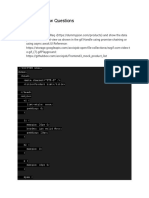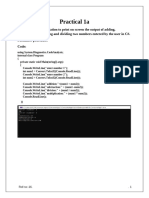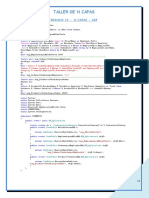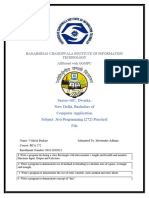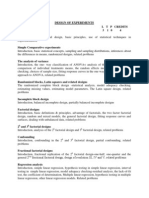0 ratings0% found this document useful (0 votes)
30 viewsCode Explanation
Code Explanation
Uploaded by
Shilpa KamagariThe code streams retail data from Kafka into Spark, processes the data using UDFs to calculate order metrics like total cost and item count, and computes time-based and country-based KPIs using window functions and writes them to files stored on HDFS. It imports functions from Spark SQL, defines the data schema, creates SparkSession, reads data from Kafka, registers UDFs, selects and transforms data, and calculates various KPIs which are written to files.
Copyright:
© All Rights Reserved
Available Formats
Download as DOCX, PDF, TXT or read online from Scribd
Code Explanation
Code Explanation
Uploaded by
Shilpa Kamagari0 ratings0% found this document useful (0 votes)
30 views3 pagesThe code streams retail data from Kafka into Spark, processes the data using UDFs to calculate order metrics like total cost and item count, and computes time-based and country-based KPIs using window functions and writes them to files stored on HDFS. It imports functions from Spark SQL, defines the data schema, creates SparkSession, reads data from Kafka, registers UDFs, selects and transforms data, and calculates various KPIs which are written to files.
Original Title
Code-Explanation
Copyright
© © All Rights Reserved
Available Formats
DOCX, PDF, TXT or read online from Scribd
Share this document
Did you find this document useful?
Is this content inappropriate?
The code streams retail data from Kafka into Spark, processes the data using UDFs to calculate order metrics like total cost and item count, and computes time-based and country-based KPIs using window functions and writes them to files stored on HDFS. It imports functions from Spark SQL, defines the data schema, creates SparkSession, reads data from Kafka, registers UDFs, selects and transforms data, and calculates various KPIs which are written to files.
Copyright:
© All Rights Reserved
Available Formats
Download as DOCX, PDF, TXT or read online from Scribd
Download as docx, pdf, or txt
0 ratings0% found this document useful (0 votes)
30 views3 pagesCode Explanation
Code Explanation
Uploaded by
Shilpa KamagariThe code streams retail data from Kafka into Spark, processes the data using UDFs to calculate order metrics like total cost and item count, and computes time-based and country-based KPIs using window functions and writes them to files stored on HDFS. It imports functions from Spark SQL, defines the data schema, creates SparkSession, reads data from Kafka, registers UDFs, selects and transforms data, and calculates various KPIs which are written to files.
Copyright:
© All Rights Reserved
Available Formats
Download as DOCX, PDF, TXT or read online from Scribd
Download as docx, pdf, or txt
You are on page 1of 3
Code Explanation
Case Study: Retail Data Analysis
In this project, we will go through a real-world use case from the retail sector.
Data from a centralised Kafka server in real-time will be streamed and
processed to calculate various KPIs or key performance indicators.
1. Various sql functions were imported from pyspark.sql.functions module.
The functions include window, udf etc.
2. Various sql types were imported from pyspark.sql.types module. The
types include StringType, ArrayType, TimestampType, IntegerType,
DoubleType etc.
3. SparkSession was imported from pyspark.sql module
4. Initialized the spark session using
spark = SparkSession \
.builder \
.appName("KafkaRead") \
.getOrCreate()
5. Streamed the data from kafka producer using
orderRaw = spark \
.readStream \
.format("kafka") \
.option("kafka.bootstrap.servers","ec2-18-211-252-152.compute-
1.amazonaws.com:9092") \
.option("subscribe","real-time-project") \
.load()
From
Bootstrap Server - 18.211.252.152
Port - 9092
Topic - real-time-project
6. Schema is defined using
jsonSchema = StructType() \
.add("invoice_no", StringType()) \
.add("country", StringType()) \
.add("timestamp", TimestampType()) \
.add("type", StringType()) \
.add("items", ArrayType(StructType([
StructField("SKU", StringType()),
StructField("title", StringType()),
StructField("unit_price", DoubleType()),
StructField("quantity", IntegerType())
])))
7. Python function is written to compute total cost of an order using
Total cost = ∑(quantity∗unitprice)
8. The above function is transformed into udf (user defined function) using
add_total_cost = udf(get_total_cost, DoubleType())
9. Python function is written to find total items in an order.
10. The above function is transformed into udf using
add_total_count = udf(get_total_item, IntegerType())
11. Python function is written to find if the order is new.
12.The above function is transformed into udf using
add_is_order_flag = udf(get_is_order, IntegerType())
13.Python function is written to find if the order is return.
14.The above function is transformed into udf using
add_is_return_flag = udf(get_is_return, IntegerType())
15. Selected data ("invoice_no", "country", "timestamp", "Total_Items",
"Total_Cost", "is_order", "is_return" ) is written to the console.
16. Time based KPI (“Window”, ”OPM”, ”Total Sales Volume”, ”Average
rate of return”, “Average Transaction Size” ) is calculated using tumbling
window function for every 1 minute
17. Time and country based KPI ((“Window”, ”Country” ,”OPM”, ”Total
Sales Volume”, ”Average rate of return”) is calculated using tumbling
window function for every 1 minute
18. The Computed KPI were written to files and stored on HDFS in json
form
19. The streaming process is manually killed after 10 mins.
You might also like
- CodeLogicDocument6 pagesCodeLogicAakash KotkarNo ratings yet
- Big Data LabDocument12 pagesBig Data LabPooja PatilNo ratings yet
- 44 Working With Future: Map and Flatmap - Get Programming With ScalaDocument8 pages44 Working With Future: Map and Flatmap - Get Programming With Scalakr.manidNo ratings yet
- T4_L8_Host_Program_PythonDocument17 pagesT4_L8_Host_Program_Pythonping71390No ratings yet
- Final Print Py SparkDocument133 pagesFinal Print Py SparkShivaraj KNo ratings yet
- BDA List of Experiments For Practical ExamDocument21 pagesBDA List of Experiments For Practical ExamPharoah GamerzNo ratings yet
- VCGV BNDocument2 pagesVCGV BNChandini RajeevNo ratings yet
- Lab Manual Cs6461 - Object Oriented Programming Lab: Valliammai Engineering College SRM Nagar, KattankulathurDocument30 pagesLab Manual Cs6461 - Object Oriented Programming Lab: Valliammai Engineering College SRM Nagar, Kattankulathursathyaraj palanisamyNo ratings yet
- jszip.jsDocument197 pagesjszip.jsSbX xNo ratings yet
- TemperatureDocument5 pagesTemperaturemathewsujith31100% (1)
- Tran Quang Kha - Full Stack EngineerDocument21 pagesTran Quang Kha - Full Stack EngineerKAI ITNo ratings yet
- Operating System - AssDocument26 pagesOperating System - Ass16213467rishNo ratings yet
- IRFinalDocument46 pagesIRFinalsahayajeicy10No ratings yet
- Assignment WPDocument53 pagesAssignment WPuttam porwalNo ratings yet
- PCPF - PRACTICAL - Manual - Output 2Document24 pagesPCPF - PRACTICAL - Manual - Output 2donnoorain69No ratings yet
- INTRODUCTIONDocument18 pagesINTRODUCTIONkavyaaNo ratings yet
- F3 Mock InterviewDocument15 pagesF3 Mock Interviewvignesh waranNo ratings yet
- Gce RequirementsDocument4 pagesGce RequirementsMatthew HarrisNo ratings yet
- marscodeDocument779 pagesmarscodesharath.kumar.20112023No ratings yet
- 2 K 22:EE:297Document8 pages2 K 22:EE:297bossdk874581No ratings yet
- NewmenuDocument7 pagesNewmenumathewsujith31No ratings yet
- Spark Job DataprocDocument4 pagesSpark Job DataprocDenys StolbovNo ratings yet
- Tugas PboDocument2 pagesTugas PboAnggito karta WijayaNo ratings yet
- Create An Spark Streaming App: 1. Architecture and AbstractionDocument8 pagesCreate An Spark Streaming App: 1. Architecture and AbstractionNgô HoàngNo ratings yet
- Dot Net Sap CodeDocument18 pagesDot Net Sap CodedebkrcNo ratings yet
- Full Stack Development Lab Programs-3Document27 pagesFull Stack Development Lab Programs-3Chitti ChittiNo ratings yet
- Requirement:: Hive/Impala/Presto Hadoop (Spark / HDFS) No SQL Database Game Server/applicationDocument4 pagesRequirement:: Hive/Impala/Presto Hadoop (Spark / HDFS) No SQL Database Game Server/applicationAshvanth RameshNo ratings yet
- Aifaz Khan AwdDocument72 pagesAifaz Khan AwdkhanaifazvlcNo ratings yet
- Guru Gobind Singh Indraprastha University: Institute of Innovation in Technology & ManagementDocument59 pagesGuru Gobind Singh Indraprastha University: Institute of Innovation in Technology & Managementdhruvsharma292005No ratings yet
- C# FileDocument25 pagesC# FileRohit TiwariNo ratings yet
- Chaincode For Developers - Hyperledger-Fabricdocs Master DocumentationDocument10 pagesChaincode For Developers - Hyperledger-Fabricdocs Master DocumentationbiarabbiaNo ratings yet
- Bda Unit 3Document22 pagesBda Unit 3Vyshnavi ThottempudiNo ratings yet
- Analyzing The Data With HadoopDocument13 pagesAnalyzing The Data With HadoopVyshnavi ThottempudiNo ratings yet
- Creating Web API in ASP - Net Core 2.0 - CodeProjectDocument36 pagesCreating Web API in ASP - Net Core 2.0 - CodeProjectGabriel GomesNo ratings yet
- Oop_Example_1Document17 pagesOop_Example_154-Hoàng Lê NamNo ratings yet
- Java Lab Manual PDFDocument66 pagesJava Lab Manual PDFVanathi PriyadharshiniNo ratings yet
- Angular NotesDocument7 pagesAngular NotesNaman Jain100% (1)
- Csharp SqliteDocument8 pagesCsharp SqliteZheng JunNo ratings yet
- Code MenuDocument7 pagesCode Menumathewsujith31No ratings yet
- Tidying Up: CloseDocument6 pagesTidying Up: ClosershegdeNo ratings yet
- Java Final ReportDocument10 pagesJava Final ReportOnkar TalekarNo ratings yet
- N Capas - ASPDocument15 pagesN Capas - ASPanrk0No ratings yet
- Java FullDocument10 pagesJava Fullaneeshshinde167No ratings yet
- Information Retrieval PracticalDocument16 pagesInformation Retrieval Practicalsahadev jagdish dhargalkar100% (1)
- Chapter 8 PDFDocument7 pagesChapter 8 PDFAnshuman TripathyNo ratings yet
- Import Import Import Import Import Import Import Import Public Class Extends ImplementsDocument7 pagesImport Import Import Import Import Import Import Import Public Class Extends ImplementsSARAVANANNo ratings yet
- JAVA Lab Manual (Vishesh Purkait)Document27 pagesJAVA Lab Manual (Vishesh Purkait)HUNTER RONYNo ratings yet
- Importer and Exporter Product For Data Analysis Based On Extract, Transform, Load (ETL) and Regular Expression With Python Programming .TewayDocument26 pagesImporter and Exporter Product For Data Analysis Based On Extract, Transform, Load (ETL) and Regular Expression With Python Programming .TewayBharat ThakurNo ratings yet
- 05 FunctionsDocument6 pages05 FunctionsjenNo ratings yet
- Cosmosdb StudyDocument41 pagesCosmosdb StudyBryan SanchezNo ratings yet
- Our Pointers For The ExamDocument4 pagesOur Pointers For The ExamjehaelcorazoNo ratings yet
- SemDocument2 pagesSemChandini RajeevNo ratings yet
- Core & ReactJSDocument33 pagesCore & ReactJSMuvvala PrudhviNo ratings yet
- Java Lab Manual - 5th Sem CseDocument23 pagesJava Lab Manual - 5th Sem CseRithika M NagendiranNo ratings yet
- Script LabDocument10 pagesScript LabTrupti SuryawanshiNo ratings yet
- Analysis of Heart Disease DatasetDocument16 pagesAnalysis of Heart Disease Datasetsswetha06052003No ratings yet
- ReportJalwaDocument17 pagesReportJalwaRizwanNo ratings yet
- CRUD Operations in Ionic2, To-Do Application - Jinal ShahDocument18 pagesCRUD Operations in Ionic2, To-Do Application - Jinal ShahJohan SamangunNo ratings yet
- 1998_1000_DOC_AI-Powered Code GenerationDocument5 pages1998_1000_DOC_AI-Powered Code GenerationJeevana SrinivasanNo ratings yet
- Format of The ThesisDocument17 pagesFormat of The ThesiskattaswamyNo ratings yet
- Aipmst Primary Practice SetDocument13 pagesAipmst Primary Practice SetDev PandeyNo ratings yet
- Mechanical Tender Evaluation ReportDocument3 pagesMechanical Tender Evaluation ReportfebousNo ratings yet
- 4045HFG92 ADocument2 pages4045HFG92 AArmando Jr AmoresNo ratings yet
- Loewe l2710 Chassis LCD TV SMDocument72 pagesLoewe l2710 Chassis LCD TV SMGsmHelp100% (2)
- Important Derivations Physics Class 12 CBSE - Chapter WiseDocument3 pagesImportant Derivations Physics Class 12 CBSE - Chapter WisePriyam RajNo ratings yet
- Lab 3 Industrial AutomationDocument8 pagesLab 3 Industrial AutomationMuhammad UmarNo ratings yet
- NTM 1 MokDocument10 pagesNTM 1 MokNick MaxNo ratings yet
- PhenylephrineDocument6 pagesPhenylephrineZyuha AiniiNo ratings yet
- WooKong M User Manual en v3.6 130130Document54 pagesWooKong M User Manual en v3.6 130130bobzybob1No ratings yet
- M. Tech WLF SyllabusDocument22 pagesM. Tech WLF SyllabusAkhil AroraNo ratings yet
- DS DVS DML DLDocument4 pagesDS DVS DML DLGabi PNo ratings yet
- 424-433, Ni Putu Hanisa Noptiana Putri, I Ketut Sunarwijaya, Ni Putu Lisa ErnawatiningsihDocument10 pages424-433, Ni Putu Hanisa Noptiana Putri, I Ketut Sunarwijaya, Ni Putu Lisa ErnawatiningsihNovi RiswantiNo ratings yet
- Jiangxi Kelley Chemical Packing Co., LTDDocument7 pagesJiangxi Kelley Chemical Packing Co., LTDdummy9158No ratings yet
- TopTherm Filter Fan UnitsDocument4 pagesTopTherm Filter Fan UnitsTILAK RAJ KambojNo ratings yet
- BSV by Example: The Next-Generation Language For Electronic System DesignDocument240 pagesBSV by Example: The Next-Generation Language For Electronic System Designaniketmohanty100% (1)
- Dynamics of Increasing The Volume and IntensityDocument5 pagesDynamics of Increasing The Volume and IntensityAizat FarhanNo ratings yet
- ABSTRACTionDocument14 pagesABSTRACTionCynthia Mae PawidNo ratings yet
- M2 Lesson 2 - Air Masses and FrontsDocument3 pagesM2 Lesson 2 - Air Masses and FrontsVILLARANTE, CHRESSYLE ANNE FABIALANo ratings yet
- Cleaning Grading & ConveyingDocument85 pagesCleaning Grading & Conveyingseema shekhawatNo ratings yet
- Whole Wall Performance Analysis of Autoclaved Aerated Concrete An Example of Collaboration Between Industry and A Research Lab On Development of Energy Efficient Building Envelope SystemsDocument12 pagesWhole Wall Performance Analysis of Autoclaved Aerated Concrete An Example of Collaboration Between Industry and A Research Lab On Development of Energy Efficient Building Envelope Systemsh2odavidNo ratings yet
- Class 8 EVS Revision Question Paper 2024-25Document3 pagesClass 8 EVS Revision Question Paper 2024-25shubham.gawaliNo ratings yet
- 1 Post GATE - 2021 Counselling - EC - StudentsDocument66 pages1 Post GATE - 2021 Counselling - EC - StudentsLovepreet SinghNo ratings yet
- Future Simple Tense (Probability 50%) : Probably, SurelyDocument2 pagesFuture Simple Tense (Probability 50%) : Probably, SurelyMacarenaNo ratings yet
- Investigating Atoms and Atomic TheoryDocument34 pagesInvestigating Atoms and Atomic Theorysophia luNo ratings yet
- Computer FundamentalsDocument86 pagesComputer FundamentalspratibhaNo ratings yet
- Section 6 Quiz: 1st Normal Form. 2nd Normal Form. 3rd Normal Form. ( ) None of The Above, The Entity Is Fully NormalisedDocument5 pagesSection 6 Quiz: 1st Normal Form. 2nd Normal Form. 3rd Normal Form. ( ) None of The Above, The Entity Is Fully NormalisedAnaXYefNo ratings yet
- CHE531 2012-JanDocument9 pagesCHE531 2012-JanBiLL ShAmSNo ratings yet
- CNS Unit 2Document32 pagesCNS Unit 2dineshsai94601No ratings yet
- Make It Home: Automatic Optimization of Furniture ArrangementDocument11 pagesMake It Home: Automatic Optimization of Furniture ArrangementTuan Huy LeNo ratings yet
















